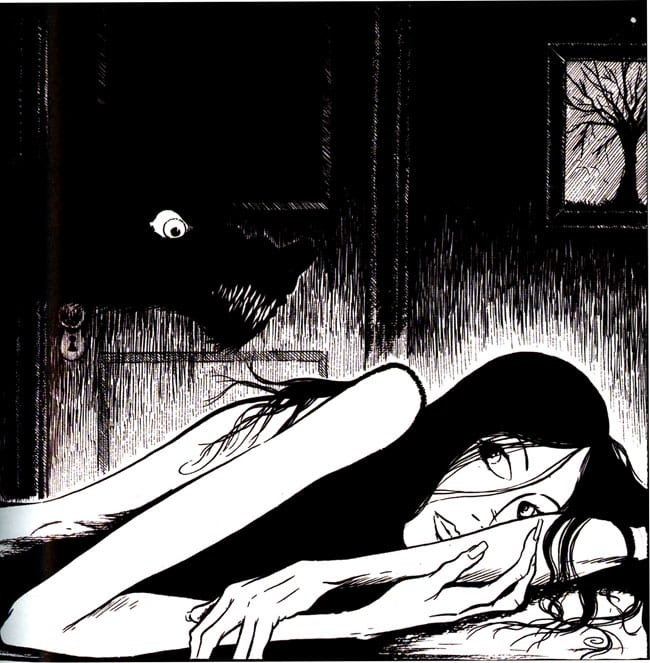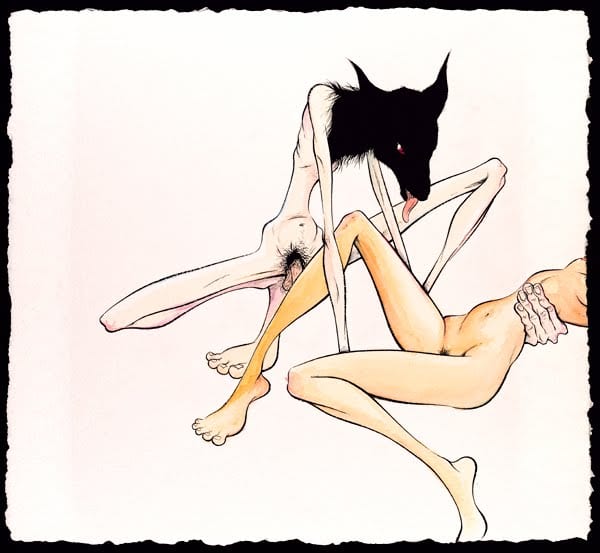Tom Neely creates images that are at once strikingly direct and yet simultaneously evasive. His newest book, The Wolf, feels just as intensely personal as his first, the startlingly original The Blot. Both books ultimately seem to be the journeys of particular relationships that move the protagonist in strikingly different directions. The fulcrum for both is lust, personified by the monstrous, visceral Wolf. In The Blot, lust is an agent of betrayal and destruction. In The Wolf, lust is an agent of creation, transformation, and freedom.
The cover is Neely's take-off on vanitas painting, a genre designed to make the viewer reflect on the ephemerality and ultimate meaninglessness of material life through still-life paintings, typically of objects such as skulls, rotting fruit, and clocks. Neely's version of this reflects an understanding of life and mortality that embraces this ephemeral quality but revels in each moment. That's reflected over and over again in this book as each page contains a single image, designed to capture and enhance the power of single moments. Even moments of dread and fear contain their own special resonance and should be understood wholly in that context.

The book begins with the Neely stand-in, an ectomorph whose angular body is so extremely concave that it threatens to collapse in on itself. After a nightmare, he awakes to see his reflection in the mirror as that of a monster. He embraces that monster, vomiting up and wearing the head of a wolf, even as his lover has disappeared. He burns his house to the ground in a moment of obvious calculation; it's a completion of a rite of passage or the rejection of a particular way of approaching life. Embracing the viscerality of his own lust and nature as a physical being brings a price: vomiting up his muscular-skeletal-nervous system. Appearing as a death's head skull as it initially presses against his chest, these figures seem to represent temporality and the flip side of being connected to one's own material urges: the understanding that we are flesh and doomed to rot.
After literally fighting off his own sense of mortality with tooth and claw, he goes in search of his mate. In a turnaround of the predatory, rapacious beast that the werewolf represents, the Wolf here is respectful and almost docile when he comes across his woman laying naked in bed. Their union is obviously one of mutual embrace and surrender that slowly builds to desire as their forms turn from black & white to full color--blood rushing to the page, as it were. That color then starts to surround the figures in an abstract fashion, as though Neely was depicting their auras. Forms then fall away, other than the scribble of hair, as Neely seems to be depicting orgasm--a literally ecstatic state that suspends thought.
After the "little death" of orgasm, however, their embodied sense of mortality returns in full force. The struggle is far less horrific than the main character's battle with the all-consuming threat of the ink in The Blot; I think Neely has a sense of the lower stakes as these forms wobble as they flail themselves against the characters. The action here is just more ridiculous and less terrifying; one can never truly lose sight of death, but it seems like both of these characters have faced up to that possibility before. Indeed, the cover of the book reflects and celebrates this understanding.
Speaking of celebration, the finale of the book contains a wedding between our protagonists, who were saved from their death-doppelgangers by a pack of wolves. Those wolves seem to be a further point of transformation or de-evolution, an idea supported by the events that occur after the wedding. The ceremony is performed by tree-men, who merge the skulls of their skeletons into a single whole that both wolf and woman drink out of. There's no ambiguity in what is obviously a wedding ceremony, where both drink freely out of the skull--a symbol of life in death, death in life. In the book's final panels, the wolf-man turns into a wolf, and the woman into a tree--with both watching over each other. While our ultimate fate is death, Neely seems to suggest that relationships can survive that barrier symbolically if both members of that couple truly embrace each other. Or perhaps this is Neely simply projecting his own wishes and desires on this situation. Regardless, the transformation from human to animal and human to vegetable seems to be a sort of escape route for the characters. They are freed from the bonds of mortality, but they also lose the vitality of lust. Neely suggests that this is no small price, but it is one the characters in this book are willing to pay in order to stay together.
The Wolf, a full-cover collection of paintings that expound a narrative in a highly oblique manner, is a bold move for a self-publishing artist. Overall, it's less complex and compelling than The Blot, which felt like it had a lot more at stake. While both works are obviously personal, The Wolf reads more like a love letter than a fully-fleshed story like The Blot. It doesn't play to Neely's strengths as a cartoonist in quite the same way, lacking the dark humor of the first book. Despite the flexibility in his use of signifiers in this book and the way that his symbols evade precise readings, the emotional context of his images is so much more direct in The Wolf than in The Blot. Still, even if the context of those images seems more obvious, with sex and death as the overarching themes of the book, his visuals qua visuals are a stunning step up. While I missed the panel-to-panel immediacy found in The Blot, Neely provides a sumptuous feast of ink on every page. I enjoyed looking at every page as a simple drawing apart from its larger context, and Neely does well to imbue each image with a kinetic, rubbery quality that lends itself to wanting to see the next painting or drawing. Neely continues to create comics that are uncompromising, beautiful, and thought-provoking. If The Wolf isn't as provocative as The Blot, that only points to how difficult an act that book is to follow.











